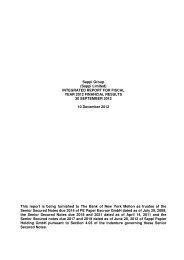2007 Annual Report - Sappi
2007 Annual Report - Sappi
2007 Annual Report - Sappi
You also want an ePaper? Increase the reach of your titles
YUMPU automatically turns print PDFs into web optimized ePapers that Google loves.
• it transfers (or it assumes an obligation to transfer) the<br />
financial asset, including substantially all the risks and<br />
rewards of ownership of the asset; or<br />
• it transfers the financial asset, neither retaining nor transferring<br />
substantially all the risks and rewards of ownership of the<br />
asset, but no longer retains control of the asset.<br />
A financial liability is derecognised when and only when the<br />
liability is extinguished, i.e. when the obligation specified in the<br />
contract is discharged, cancelled or has expired.<br />
The difference between the carrying amount of a financial asset<br />
or financial liability (or part thereof) that is derecognised and the<br />
consideration paid or received, including any non-cash assets<br />
transferred or liabilities assumed, is recognised in selling,<br />
general and administration in profit or loss for the period.<br />
(vi) Impairment of financial assets<br />
An impairment is recognised when there is evidence that the<br />
group will not be able to collect all amounts due according<br />
to the original terms of the receivables. The amount of the<br />
impairment is charged to the income statement.<br />
• Available-for-sale financial assets<br />
When a decline in the fair value of an available-for-sale financial<br />
asset has been recognised directly in equity and there is<br />
objective evidence that the asset is impaired, the cumulative<br />
loss that has been recognised directly in equity is removed<br />
from equity and recognised in profit or loss even though the<br />
financial asset has not been derecognised. The amount of the<br />
cumulative loss that is removed from equity and recognised in<br />
profit or loss is the difference between the acquisition cost (net<br />
of any principal repayment and amortisation) and current fair<br />
value, less any impairment loss on that financial asset previously<br />
recognised in profit or loss. Impairment losses recognised in<br />
profit or loss for an investment in an equity instrument classified<br />
as available-for-sale are not reversed through profit or loss.<br />
If, in a subsequent period, the fair value of a debt instrument<br />
classified as available-for-sale increases and the increase can<br />
be objectively related to an event occurring after the impairment<br />
loss was recognised in profit or loss, the impairment loss is<br />
reversed, with the amount of the reversal recognised in profit or<br />
loss for the period.<br />
(vii) Hedge accounting<br />
Hedge accounting recognises the offsetting effects on profit or<br />
loss of changes in the fair values of the hedging instrument and<br />
the hedged item.<br />
Hedging relationships are of three types:<br />
• Fair value hedges<br />
If a fair value hedge meets the conditions for hedge accounting,<br />
any gain or loss on the hedged item attributable to the hedged<br />
risk is included in the carrying amount of the hedged item and<br />
recognised in profit or loss. The changes in the fair value of the<br />
hedging instrument and the hedged item is recognised in net<br />
finance costs in profit or loss.<br />
• Cash flow hedges<br />
The group does not currently apply cash flow hedge accounting.<br />
• Hedge of a net investment in a foreign operation<br />
The group does not currently have any hedges of net<br />
investments in foreign operations.<br />
Hedge accounting is discontinued on a prospective basis when<br />
the hedge no longer meets the hedge accounting criteria<br />
(including when it becomes ineffective), when the hedge<br />
instrument is sold, terminated or exercised when, for cash flow<br />
hedges, the designation is revoked and the forecast transaction<br />
is no longer expected to occur. Any cumulative gain or loss on<br />
the hedging instrument for a forecast transaction is retained in<br />
equity until the transaction occurs, unless the transaction is no<br />
longer expected to occur, in which case it is transferred to profit<br />
or loss for the period.<br />
(viii) Offsetting financial instruments and<br />
related income<br />
Financial assets and liabilities are offset and the net amount<br />
reported in the balance sheet only when there is a legally<br />
enforceable right to set off and there is an intention of settling<br />
on a net basis or realising the asset and settling the liability<br />
simultaneously. Income and expense items are offset only to<br />
the extent that their related instruments have been offset in the<br />
balance sheet, with the exception of those relating to hedges,<br />
which are disclosed in accordance with the profit or loss effect<br />
of the hedged item.<br />
(ix) Interest income and expense<br />
Interest income and expense are recognised in profit or loss<br />
using the effective interest rate method taking into account the<br />
expected timing and amount of cash flows.<br />
(x) Other<br />
Dividends from investments and gains or losses on the sale of<br />
investments are recognised in profit or loss when the amount of<br />
revenue from the transaction or service can be measured<br />
reliably, it is probable that the economic benefits of the<br />
sappi limited | 07 | annual report 79
















